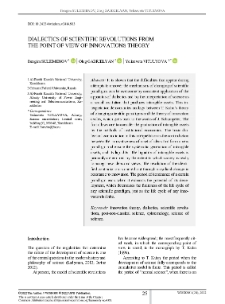Object
Title: Dialectics of Scientific Revolutions from the Point of View of Innovations Theory
Journal or Publication Title:
Date of publication:
Volume:
Number:
ISSN:
Corporate Creators:
Խ․ Աբովյանի անվան հայկական պետական մանկավարժական համալսարան
Coverage:
Abstract:
It is shown that the difficulties that appear during attempts to uncover the mechanisms of changing of scientific paradigms can be overcome by consistent application of the apparatus of dialectics and by the interpretation of science as a social institution that produces intangible assets. This interpretation demonstrates analogy between T. Kuhn‟s theory of changing scientific paradigms and the theory of innovation cycles, which goes back to the works of J. Schumpeter. The fact allows one to consider the production of intangible assets by the methods of institutional economics. The basic dialectical contradiction in this interpretation is the contradiction between the innovativeness of a set of ideas that form a new paradigm and ensure the systematic generation of intangible assets, and its liquidity. The liquidity of intangible assets is primarily determined by the extent to which society is ready to accept new ideas and views. The resolution of the identified contradiction is carried out through a cyclical change in resistance to innovation. The period of dominance of a certain paradigm ends when it exhausts the potential of its development, which determines the finiteness of the life cycle of any scientific paradigm, just as the life cycle of any innovation is finite.
Place of publishing:
Երևան
Publisher:
Format:
Identifier:
oai:arar.sci.am:372247
Language:
Object collections:
Last modified:
Oct 8, 2025
In our library since:
Apr 3, 2024
Number of object content hits:
75
All available object's versions:
https://arar.sci.am/publication/402169
Show description in RDF format:
Show description in OAI-PMH format:
-
Իմաստություն=Wisdom=Мудрость
-
Իմաստություն, 2013, N 1
-
Իմաստություն, 2014, N 1 (2)
-
Իմաստություն, 2014, N 2 (3)
-
Իմաստություն, 2015, N 1 (4)
-
Wisdom, 2015, N 2 (5)
-
Wisdom, 2016, N 1 (6)
-
Wisdom, 2016, N 2 (7)
-
Wisdom, 2017, N 1 (8)
-
Wisdom, 2017, N 2 (9)
-
Wisdom, 2018, N 1 (10)
-
Wisdom, 2018, N 2 (11)
-
Wisdom, 2019, N 1 (12)
-
Wisdom, 2019, N 2 (13)
-
Wisdom, 2020, N 1 (14)
-
Wisdom, 2020, N 2 (15)
-
Wisdom, 2020, N 3 (16)
-
Wisdom, 2021, N 1 (17)
-
Wisdom, 2021, N 1 (1) Special issue
-
Wisdom, 2021, N 2 (18)
-
Wisdom, 2021, N 3 (19)
-
Wisdom, 2021, N 4 (20)
-
Wisdom, 2022, N 1 (21)
-
Wisdom, 2022, N 1 (2) Special issue
-
Wisdom, 2022, N 2 (22)
-
Wisdom, 2022, N 2 (3) Special issue
-
Wisdom, 2022, N 3 (23)
-
Wisdom, 2022, N 3 (4) Special issue
-
Wisdom, 2022, N 4 (24)
- Editorial board
- Contents
- Editor`s Foreword
- The Problem and Methodology of Studying the Diaspora Armenians’ Entrepreneurship Motives in Homeland
- Methodological Analysis of Strategies and Tactics in Literary Discourse
- Dialectics of Scientific Revolutions from the Point of View of Innovations Theory
- Genetic Determinism and the Problem of Moral Responsibility or is Morality Possible Without Freedom?
- Social-Psychological and Legal-Philosophical Characteristics of Personality Anomie
- Philosophical-Anthropological Concepts of Subject and Subjectivity as a Genesis of Women’s Emancipation
- Philosophical Analysis of the Concept Human Situation
- Gender Egalitarianism as a Value of International Labor Relations
- The Phenomenon of Education in the Context of an Intercultural Philosophical Approach
- The Philosophy of External Public Debt Management
- Safe Development of Russian Education in the Context of Its Crisis
- The Presidential Electoral System: A Philosophical Analysis
- Philosophical-Linguistic Analysis of the Idea of Freedom
- The Issue of Regulating Human Rights and Freedoms in Modern Transforming Society
- Revisiting the Originality of Indonesian Philosophy (Indonesian Humankind and Philosophical Identity)
- The Philosophy of Assets Fair Value Presentation in Financial Statements
- Religion and Law in the Post-Secular World: Cooperation Between the State and Religions in Legislative Activities
- The Role of Intellectual Islamic Heritage in the Discourse of Modern Islamic Philosophy
- Philosophical Foundations of the Legal Language
- Developing Islamic Legal Philosophy-Based Assurance of Justice
- The Issue of Public Officials’ Promises in the Light of Philosophy of State
- Art as Inner Knowledge: Dino Valls
- The “Yin” and “Yang” Ancient Chinese Philosophy and its Practical Application to Body Treatment
- Linos G. Benakis
- Notes to Contributors
-
Wisdom, 2023, N 1 (25)
-
Wisdom, 2023, N 2 (26)
-
Wisdom, 2023, N 3 (27)
-
Wisdom, 2023, N 4 (28)
-
Wisdom, 2024, N 1 (29)
-
Wisdom, 2024, N 2 (30)
-
Իմաստություն, 2013, N 1
| Edition name | Date |
|---|---|
| Suleimenov, Ibragim, Dialectics of Scientific Revolutions from the Point of View of Innovations Theory | Oct 8, 2025 |





